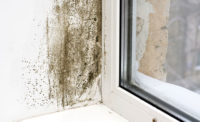The initial impression of a house being inspected for mold is most likely going to be the apparent age of the home and the materials used to construct it. Many would normally assume that old homes, with their aging building materials and prolonged exposure to the elements, present a higher risk for interior mold growth than newer buildings. In some cases, this may be true. Homes built in the 70’s are often found to have poor ventilation and air circulationin certain rooms or floors, and stagnant air can be the catalyst that turns a condensation issue into a mold problem. However, because of the particular building materials and architectural designs common in the new houses cropping up today, it really does seem that older is better when it comes to having fears of mold in the home.
Building Materials: Food for Mold
Like anything else living in this world, mold needs water and mold needs food to eat. In this case, mold’s meal of choice is either the walls of the home in question or the dust that has collected on them. Of course, some walls provide a better environment for mold growth – it can just be a little surprising to learn that many of us are building our homes with more mold-friendly materials than 50 years ago.
Moisture breeds mold, yet the building materials of a home can absorb and store a certain amount of water before they reach a saturation threshold. Until this point, water will not condense or collect in puddles, so mold will likely not be a problem. What’s important to know is that different building materials hold water at different levels. Here is a quick rundown of common building materials and their susceptibility to mold:
- Solid Lumber: Common in old buildings, solid lumber made from heartwood rather than sapwood (older, more resistant to decay) can hold a significant amount of moisture before condensation occurs.
- Sheathing Plywood: Created by fusing strips of mainly sapwood, plywood cannot hold moisture as well as solid lumber. The “buffer capacity,” or the saturation threshold of sapwood is lower than that of heartwood, making plywood less adept at avoiding mold.
- Particleboard & MDF: Made from completely ground down sawdust, fungi are often drawn to any underlayment and flooring built from particleboard and medium-density fibreboard.
- Paper-faced drywall: Nearly commonplace in new homes, the paper that we lace our interior walls with holds virtually no moisture and takes the cake from the other materials for the most susceptible to mold growth.
A home built from solid lumber is the most mold-safe wood home to live in, but what about the old brick-and-mortar establishments?
Brick is king, but only if it’s done right
Bricks are like sponges when compared with other building materials. It is a rare sight to find a 100-year-old house built by brick masons that has water and mold problems. However, this is not due to perfect, leak-proof walls. Brick will always leak water in some capacity, that much is unavoidable. But it is the way in which brick foundations are built that determines whether water leaks will lead to something worse.
According to Tim Carter from askthebuilder.com, brick homes will leak unless the following precautionsare taken:
- Brick is laid in a way that protects the wood framing of the house from getting wet.
- The structure collects all water that leaks through the walls.
- All of this collected water is redirected back to the exterior as quickly as possible.
Unfortunately, bricklaying industry standards have notably diminished since those early 20th century golden days, and an increased risk for leaks in a brick foundation mean a newer brick home may pose just as high a mold risk as any other new home.
Building age is a restoration professional’s first clue
If you are inspecting a home for mold or water damage, your biggest clue is directly under your nose the moment you arrive on the property. How old is the building and what was it constructed of? These are important questions to answer straightaway so that every step of the inspection process– locating mold, identifying the water source, moving forward with remediation – can be based on sound information.




Report Abusive Comment